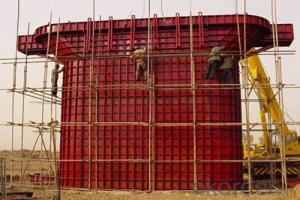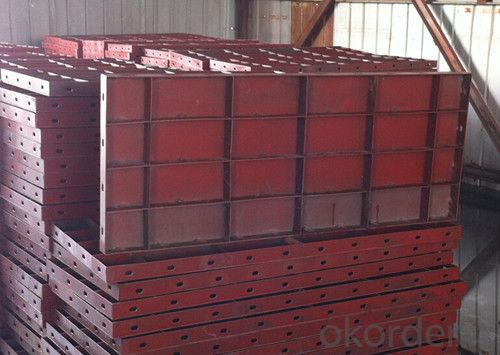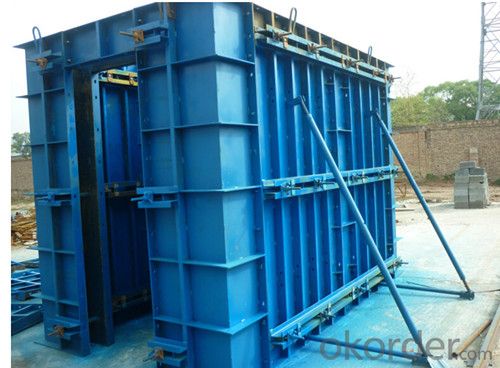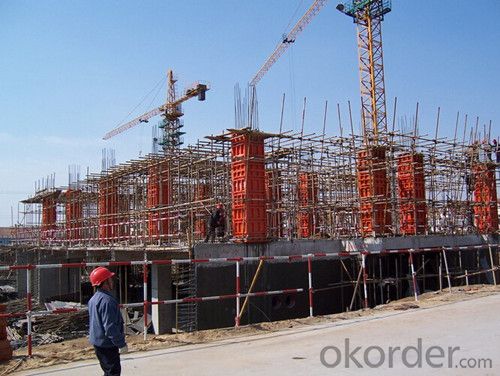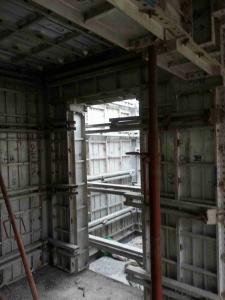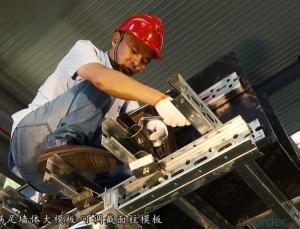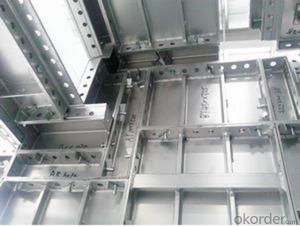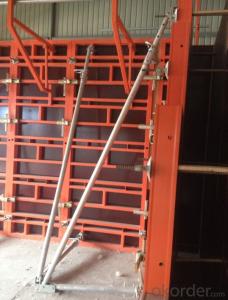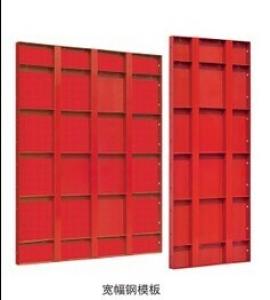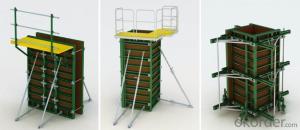Steel Formwork for High Residential Buildings with Recycling
- Loading Port:
- Tianjin
- Payment Terms:
- TT OR LC
- Min Order Qty:
- 200 pc
- Supply Capability:
- 100000 pc/month
OKorder Service Pledge
OKorder Financial Service
You Might Also Like
Introduction for Steel Formwork :
Steel Formwork:used in highway,railway,bridge,tunnel and shearing wall,etc.Our company CNBM which is one of the largest State-Owned Enterprises in China which established in 1984 , has gained the confirmation from the specialist of China Architecture Scence Institute, and has been used by many building operation units and has been highly praised.In 2014, the total turnover volume of CNBM exceeds US$410 billion dollars with a total staff of 180,000. CNBM is listed in the World Top 500 Enterprises !
Characteristic for Wholly Steel Formwork :
1. High Smooth Surface
2. Convex ling for Edge Rib
3. Specialized Connection Pin for Edge Rib Connection
4. High Stiffness for Steel Surface
5. Light Weight for saving producing cost
6. Fast Separate and Easy transport
7. Recycling using
8. Scientific and Reasonable design to meet different working condition
Parameter and Specification :
Code | Size (mm) | Weight (KG) | Code | Size (mm) | Weight (KG) |
P12021 | 1200*2100*55 | 102.96 | P4018 | 400*1800*55 | 28.3 |
P12018 | 1200*1800*55 | 88.4 | P4015 | 400*1500*55 | 23.8 |
P12015 | 1200*1500*55 | 74.15 | P4012 | 400*1200*55 | 19.1 |
P12012 | 1200*1200*55 | 60.11 | P4009 | 400*900*55 | 14.6 |
P10018 | 1000*1800*55 | 76.01 | P4007 | 400*750*55 | 12.3 |
P10015 | 1000*1500*55 | 63.96 | P4006 | 400*600*55 | 9.95 |
P10012 | 1000*1200*55 | 60.11 | P3018 | 300*1800*55 | 20.7 |
P10009 | 1000*900*55 | 39.32 | P3015 | 300*1500*55 | 17.4 |
P9018 | 900*1800*55 | 70.89 | P3012 | 300*1200*55 | 14 |
P9015 | 900*1500*55 | 59.47 | P3009 | 300*900*55 | 10.7 |
P9012 | 900*1200*55 | 48.03 | P3007 | 300*750*55 | 8.8 |
P7518 | 750*1800*55 | 57.8 | P3006 | 300*600*55 | 7.3 |
P7515 | 750*1500*55 | 48.47 | P3004 | 300*400*55 | 5.46 |
P7512 | 750*1200*55 | 39.16 | P2515 | 250*1500*55 | 15.17 |
P7509 | 750*900*55 | 29.85 | P2512 | 250*1200*55 | 12.24 |
P7507 | 750*750*55 | 24.81 | P2509 | 250*900*55 | 9.32 |
P6018 | 600*1800*55 | 43.1 | P2507 | 250*750*55 | 7.71 |
P6015 | 600*1500*55 | 36.3 | P2506 | 250*600*55 | 6.39 |
P6012 | 600*1200*55 | 31.7 | P2015 | 200*1500*55 | 11.6 |
P6009 | 600*900*55 | 23.9 | P2012 | 200*1200*55 | 9.4 |
P6007 | 600*750*55 | 18.55 | P2009 | 200*900*55 | 7.1 |
P6006 | 600*600*55 | 16.25 | P2007 | 200*750*55 | 5.9 |
P5018 | 500*1800*55 | 36.27 | P2006 | 200*600*55 | 6.39 |
P5015 | 500*1500*55 | 30.15 | P2004 | 200*450*55 | 3.64 |
P5012 | 500*1200*55 | 25.55 | P1515 | 150*1500*55 | 9.5 |
P5009 | 500*900*55 | 20.38 | P1506 | 150*600*55 | 4 |
P5007 | 500*750*55 | 15.48 | P1504 | 150*450*55 | 2.98 |
P5006 | 500*600*55 | 13.58 | P1015 | 100*1500*55 | 7.5 |
Code | Size (mm) | Weight (KG) |
P1012 | 100*1200*55 | 6.9 |
P1009 | 100*900*55 | 4.6 |
P1007 | 100*750*55 | 3.8 |
P1006 | 100*600*55 | 3.1 |
P1004 | 100*450*55 | 2.33 |
E1515 | 150*150*1500 | 15.2 |
E1512 | 150*150*1200 | 12.26 |
E1509 | 150*150*900 | 9.34 |
E1507 | 150*150*750 | 7.77 |
E1506 | 150*150*600 | 6.46 |
E1504 | 150*150*450 | 4.87 |
E1015 | 100*150*1500 | 13.13 |
E1012 | 100*150*1200 | 10.61 |
E1009 | 100*150*900 | 8.07 |
E1006 | 100*150*600 | 5.44 |
Y1018 | 100*150*1800 | 14.56 |
Y1015 | 100*150*1500 | 12.29 |
Y1012 | 100*150*1200 | 9.72 |
Y1009 | 100*150*900 | 7.46 |
Y1007 | 100*150*700 | 6.19 |
Y1006 | 100*150*600 | 5.19 |
Y1004 | 100*150*450 | 3.92 |
J0018 | 50*50*1800 | 4.34 |
J0015 | 50*50*1500 | 3.7 |
J0012 | 50*50*1200 | 2.94 |
J0009 | 50*50*900 | 2.3 |
J0007 | 50*50*750 | 1.9 |
J0006 | 50*50*600 | 1.5 |
J0004 | 50*50*450 | 1.13 |
FAQ :
1. Who are we ?
We , CNBM , are a State-Owned Enterprise which established in 1984 , have 32 years experience ,enjoy high reputation .
2. Our Advantage :
Customized products , we have our own R&D department , we can design the drawing and suggest the suitable solution for your project .
3. Our after-Sales Service :
The international Sales Manager and Engineer can go to your job site for work direction and help you deal with your project .
Factory Photos :
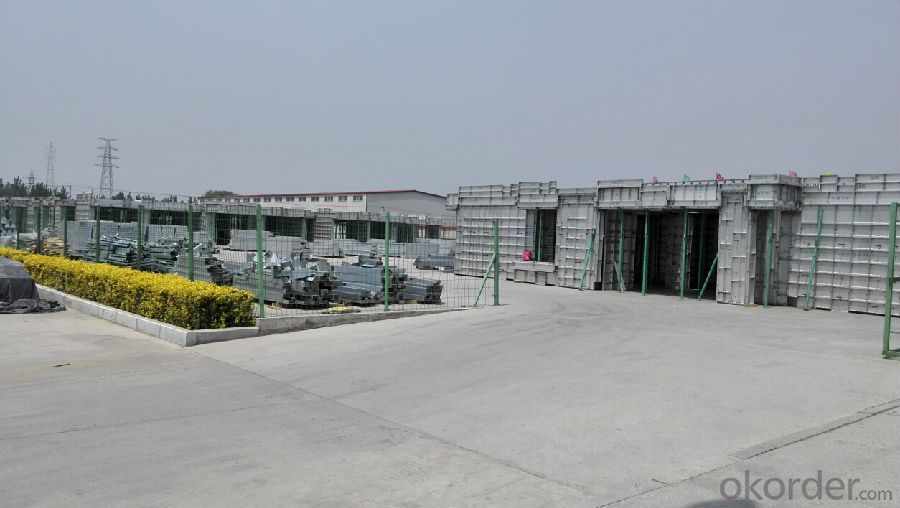
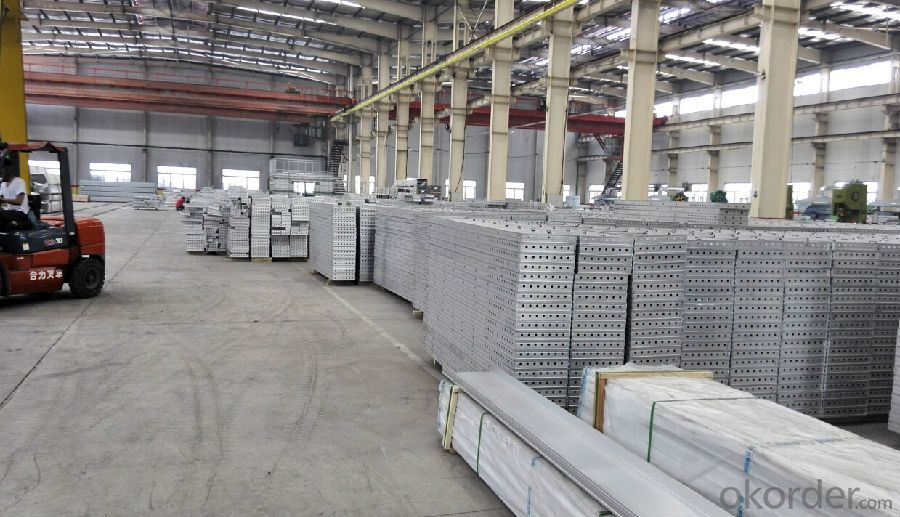

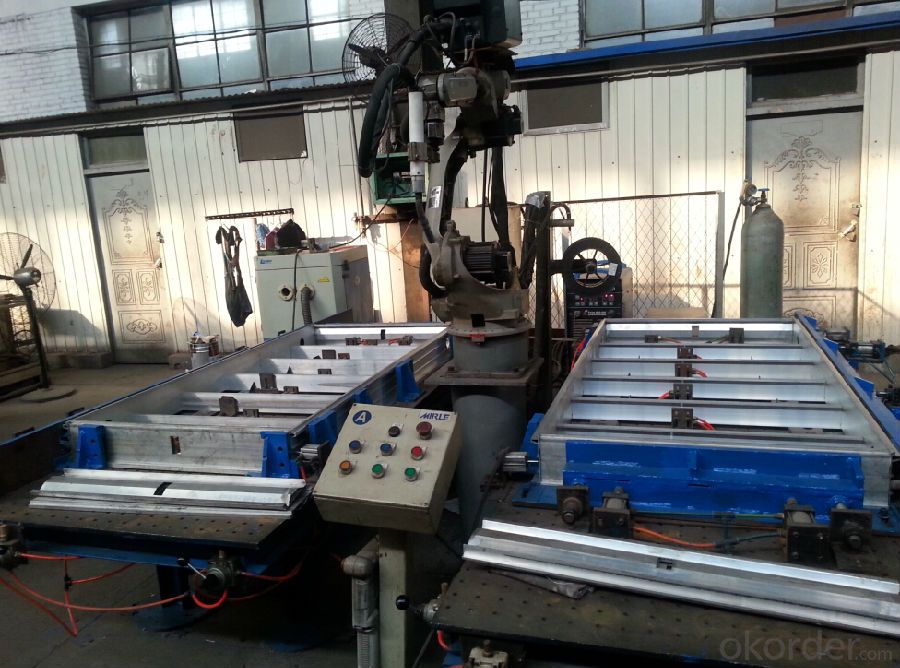
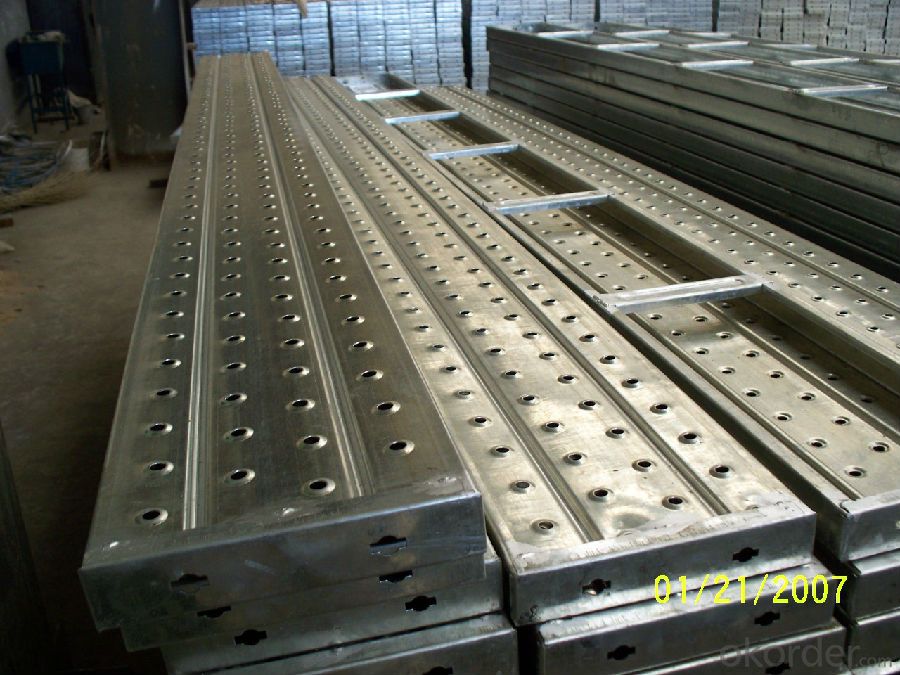
- Q: Can steel formwork be used for projects with stringent quality requirements?
- Steel formwork is definitely suitable for projects that have strict quality requirements. It is well-known for its durability, strength, and consistency, making it a great option for projects that require precision, accuracy, and high-quality finishes. With the ability to withstand heavy loads and maintain its shape and dimensions over multiple uses, steel formwork ensures that concrete structures are formed accurately and precisely according to design specifications. Additionally, steel formwork provides a smooth surface finish, reducing the need for extensive post-construction finishing work. Its robustness and stability make it a suitable choice for projects that require strict quality control, such as high-rise buildings, bridges, and infrastructure projects. Moreover, steel formwork allows for easy customization, enabling contractors to efficiently meet specific project requirements. Overall, steel formwork is a reliable and efficient choice for projects with stringent quality requirements, guaranteeing that the final structure meets the highest standards of quality and durability.
- Q: How does steel formwork handle different concrete surface texture requirements?
- Steel formwork is a versatile and durable option that can handle a variety of concrete surface texture requirements. With its adjustable and customizable design, it allows for different surface finishes to be achieved. One way steel formwork meets different concrete surface texture requirements is by being easily modified and adapted. By adjusting the steel formwork panels, various finishes such as smooth, textured, or patterned concrete can be accommodated. This flexibility makes it suitable for a wide range of construction projects, from simple slabs to complex structures. Additionally, steel formwork ensures a smooth and consistent surface, which is crucial for achieving the desired concrete finish. The rigid and sturdy nature of steel prevents any distortions or imperfections from occurring during the pouring and curing process, resulting in a uniform surface texture, regardless of the design's complexity. Moreover, steel formwork offers excellent resistance to wear and tear, making it suitable for projects that require repetitive use or high-volume concrete pouring. Its durability allows it to maintain its shape and integrity even after multiple uses, ensuring consistent concrete surface texture requirements are met over time. In conclusion, steel formwork is a reliable and adaptable solution for addressing various concrete surface texture requirements. Its adjustability, durability, and ability to provide a smooth and consistent surface make it an ideal choice for achieving different finishes, regardless of the project's complexity.
- Q: Can steel formwork be used in heritage or conservation projects?
- Yes, it is possible to utilize steel formwork in heritage or conservation projects. Steel formwork possesses numerous advantages that render it appropriate for such endeavors. Firstly, steel formwork exhibits exceptional durability and longevity, making it indispensable when working on historical structures that necessitate preservation for future generations. It can endure the challenges of construction and can be reused multiple times, thus offering a cost-effective solution. Furthermore, steel formwork provides outstanding strength and stability, guaranteeing accurate and precise concrete placement. This is particularly critical in heritage projects where maintaining the original design and structural integrity is paramount. The adaptability of steel formwork also enables the replication of intricate detailing and complex shapes, thereby making it suitable for recreating historic architectural features. Moreover, steel formwork is highly resistant to warping, shrinking, or expanding due to temperature fluctuations and moisture, which are often encountered in conservation projects. This resistance ensures the formwork's stability throughout the construction process, reduces the risk of harm to the heritage structure, and aids in preserving the overall structural integrity. Nevertheless, it is crucial to take into account the specific requirements and limitations of each heritage or conservation project. Certain projects may have stringent guidelines mandating the use of traditional materials, rendering steel formwork unsuitable. It is imperative to consult with heritage experts and conservation specialists to ensure that the use of steel formwork aligns with the project's objectives and adheres to all necessary preservation standards.
- Q: How does steel formwork perform in seismic-prone areas?
- Steel formwork performs well in seismic-prone areas due to its inherent strength and durability. Unlike other types of formwork, such as timber or plywood, steel formwork offers superior resistance to seismic forces. It provides a rigid and stable structure that can withstand the lateral forces generated during an earthquake. One of the key advantages of steel formwork in seismic-prone areas is its ability to maintain structural integrity and stability. The high tensile strength of steel enables it to resist the strong shaking and ground motions associated with seismic activity. This means that steel formwork is less likely to deform, crack, or collapse during an earthquake, ensuring the safety of the structure and the workers involved in construction. Moreover, steel formwork has excellent load-bearing capacity, which is crucial in seismic-prone areas. The formwork system provides robust support to the concrete during casting and curing, ensuring that the structure remains intact even under dynamic loading conditions. This ability to withstand heavy loads is particularly important in earthquake-resistant design, as it helps prevent structural failure and the consequent loss of life and property. In addition to its strength, steel formwork offers other benefits in seismic-prone areas. It is highly reusable, durable, and resistant to moisture, which makes it ideal for construction projects in regions with high seismic activity. The reusability of steel formwork reduces construction waste and allows for cost savings in the long run. Furthermore, steel formwork is versatile and adaptable, making it suitable for various structural applications in seismic-prone areas. It can be easily customized to fit different shapes and sizes, allowing for efficient construction of complex structures. This flexibility is crucial in earthquake-resistant design, where the formwork needs to conform to specific architectural and structural requirements. Overall, steel formwork is an excellent choice for construction in seismic-prone areas. Its strength, durability, load-bearing capacity, reusability, and adaptability make it a reliable and efficient solution to withstand the forces exerted by earthquakes. By utilizing steel formwork, construction projects can enhance the safety and resilience of structures in regions prone to seismic activity.
- Q: How does steel formwork handle different weather conditions?
- Steel formwork is known for its durability and resistance to various weather conditions. It has the ability to handle extreme temperatures, heavy rain, strong winds, and even snow. One of the main advantages of steel formwork is its ability to withstand high temperatures. It does not deform or lose its structural integrity when exposed to extreme heat. This makes it suitable for use in hot climates where temperatures can reach high levels. In addition, steel formwork does not absorb heat easily, which means it remains cool to the touch even in direct sunlight. Steel formwork is also highly resistant to heavy rain and water exposure. It does not rot, warp, or degrade when in contact with water, making it ideal for use in areas with high rainfall or high humidity. Additionally, steel does not absorb moisture, preventing the growth of mold or mildew, which can be a concern with other types of formwork materials. Another advantage of steel formwork is its ability to withstand strong winds. The inherent strength and rigidity of steel make it highly resistant to wind loads. This is particularly important in areas prone to hurricanes, cyclones, or strong gusts of wind. Steel formwork provides stability and ensures that the structure remains intact even during severe weather conditions. Furthermore, steel formwork is capable of handling snow and cold temperatures. It does not crack or become brittle when exposed to freezing temperatures, making it suitable for use in cold climates. The strength and durability of steel formwork ensure that it can handle the weight of accumulated snow without any structural damage. In summary, steel formwork is a reliable and robust solution that can handle different weather conditions effectively. Its ability to withstand extreme temperatures, heavy rain, strong winds, and snow make it a popular choice in construction projects worldwide.
- Q: How does steel formwork impact the overall project budgeting?
- Steel formwork can have a significant impact on the overall project budgeting. While it may have a higher upfront cost compared to other formwork materials, such as timber or plastic, steel formwork offers several benefits that can ultimately result in cost savings. Its durability and reusable nature allow for multiple project uses, reducing the need for frequent replacements or repairs. Additionally, steel formwork provides better precision and structural stability, leading to improved construction quality and reduced material waste. These factors, combined with increased productivity due to faster assembly and dismantling times, can contribute to a more efficient construction process and ultimately lower overall project costs.
- Q: Can steel formwork be used in industrial construction projects?
- Certainly, steel formwork is a viable option for industrial construction projects. Renowned for its robustness, durability, and ability to bear heavy loads, steel formwork proves suitable for demanding applications such as industrial construction. It can effectively withstand the immense pressure exerted by substantial concrete pours and can be used repeatedly, making it a cost-effective choice for extensive undertakings. Moreover, steel formwork guarantees a smooth and consistent finish to the concrete structure, ensuring exceptional quality outcomes. Furthermore, it offers adaptability in design, allowing for customization to cater to the specific needs of industrial construction ventures. In summary, steel formwork presents itself as a dependable and efficient solution for industrial construction projects.
- Q: Can steel formwork be used for complex geometric shapes?
- Yes, steel formwork can be used for complex geometric shapes. Steel is a highly versatile and flexible material that can be easily molded and shaped to meet the requirements of various intricate designs. It offers excellent strength and durability, making it suitable for constructing formwork for complex architectural and structural shapes. Steel formwork can be fabricated and customized to achieve precise angles, curves, and dimensions, allowing for the creation of intricate and unique shapes in construction projects. Additionally, steel formwork can be reused multiple times, making it a cost-effective option for projects that require complex geometric shapes. Overall, steel formwork provides the necessary flexibility, strength, and durability to successfully accommodate complex architectural and structural designs.
- Q: How does steel formwork handle construction joints?
- Steel formwork is a versatile and durable option for handling construction joints. It is specifically designed to handle the demands of construction joints and ensure a seamless and efficient construction process. Firstly, steel formwork is known for its strength and stability, which allows it to withstand the pressure and weight exerted on construction joints. This ensures that the formwork remains intact and in place, even when concrete is poured and compacted at the joints. Additionally, steel formwork is highly flexible and can be easily adjusted to accommodate various shapes and sizes of construction joints. This allows for precise and accurate placement of the formwork, ensuring that the joints are properly formed and aligned. Moreover, steel formwork is reusable, which makes it a cost-effective option for handling construction joints. Once the concrete has cured and the formwork is removed, it can be cleaned, repaired if necessary, and used again for subsequent construction projects. This reduces the need for additional formwork materials and minimizes waste. Furthermore, steel formwork provides a smooth and even surface finish, which is crucial for construction joints. It helps to prevent any leakage or seepage of concrete at the joints, ensuring that the structure remains watertight and structurally sound. In conclusion, steel formwork is an excellent choice for handling construction joints. Its strength, flexibility, reusability, and ability to provide a smooth surface finish make it a reliable and efficient solution for construction projects of all sizes and complexities.
- Q: Are there any specific building codes or regulations related to steel formwork?
- Yes, there are specific building codes and regulations related to steel formwork. These codes and regulations vary by country and region, but they generally cover aspects such as design, construction, installation, and safety requirements for steel formwork systems. These regulations ensure that steel formwork structures meet the necessary standards for strength, stability, and durability, while also addressing issues such as fire resistance, load capacity, and worker safety. Compliance with these codes and regulations is crucial to ensure the successful and safe use of steel formwork in construction projects.
Send your message to us
Steel Formwork for High Residential Buildings with Recycling
- Loading Port:
- Tianjin
- Payment Terms:
- TT OR LC
- Min Order Qty:
- 200 pc
- Supply Capability:
- 100000 pc/month
OKorder Service Pledge
OKorder Financial Service
Similar products
Hot products
Hot Searches
Related keywords
